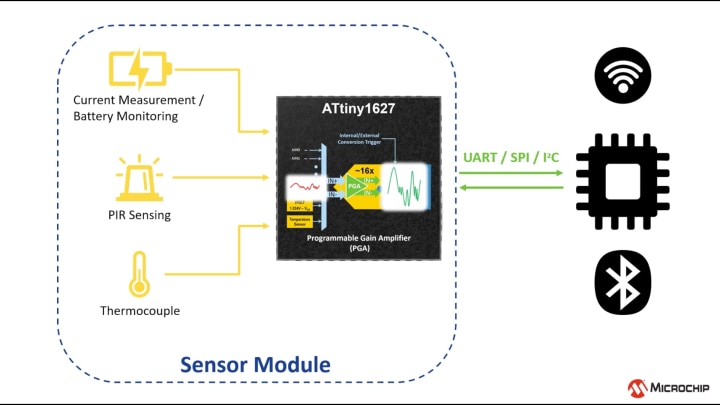Live Chat
Need Help?
Privacy PolicyEffortless Design
New Products
AVR EB Family
The AVR EB product family combines powerful Core Independent Peripherals (CIPs) with the robust and efficient AVR CPU core to create a family of MCUs that is capable of driving highly accurate systems, optimizing system performance and reducing BOM cost.
PIC18-Q84 Family
The PIC18-Q84 family of 8-bit MCUs combines an extensive array of CIPs with Controller Area Network Flexible Data Rate (CAN FD) for automotive interface and smart sensor networks.
PIC18-Q20 Family
With on-chip I3C® peripherals and multi-voltage I/O, this product family supports the increasing demand for small, responsive sensor nodes to facilitate real-time control and connected designs.
AVR EA Family
The AVR EA family, with its powerful AVR CPU, integrated analog and Core Independent Peripherals (CIPs), enables you to build compact designs with built-in flexibility and lower system cost.
PIC16F18146 Family
This microcontroller family is for cost-effective sensor-node applications. These devices simplify the connection of many kinds of sensors to more complex systems.
AVR DD Family
The AVR DD family builds upon the low-power performance of the AVR architecture with a world-class selection of Core Independent Peripherals and a fully loaded intelligent analog portfolio, giving you the freedom to innovate with your designs.
PIC16F17146 Family
This family of MCUs is packed full of peripherals to enable low-cost analog sensor applications.
PIC16F18076 Family
This family contains a robust suite of digital and analog peripherals that enable cost-sensitive sensor and real-time control applications.
PIC16F15244 Family
Upscale your designs with this cost-sensitive family of MCUs that offers an unparalleled performance-to-size ratio.
PIC18-Q41 Family
Improve your sensor node design with this low-pin-count family of MCUs that features sophisticated analog peripherals and powerful CIPs for small, high-performance data acquisition and sensor applications.
AVR DB Family
Take advantage of the integrated level shifters and three highly configurable op amps to implement real-time control functionality in a variety of industrial control, home appliance, automotive, IoT and other applications.
PIC18-Q71 Family
Take advantage of two highly configurable op amps and a rich set of Core Independent Peripherals to implement real-time control functionality in a variety of industrial control, home appliance, automotive, Internet of Things (IoT) and other applications.
ATtiny1627 Family
Improve real-time performance with high-speed measurement, or measure small amplitude signals in harsh and noisy environments with the 12-bit differential ADC and Programmable Gain Amplifier (PGA).
Try a Live Demo
Are you an embedded application engineer embarking on your next project and looking to use the on-chip peripherals of our PIC and AVR MCUs? Do you seek practical, hands-on exposure to grasp the functionality of these features? Now, you can engage with our live demonstrations displayed on your screen from any location. Microchip Try is a platform tailored for visual learners that offers interactive, real-time demos where you can modify variables and observe how the demos react.
Featured 8-bit Analog Families
PIC18-Q41 Family
Improve your sensor node design with this low-pin-count family of MCUs that features sophisticated analog peripherals and powerful CIPs for small, high-performance data acquisition and sensor applications.
AVR DB Family
Take advantage of the integrated level shifters and three highly configurable op amps to implement real-time control functionality in a variety of industrial control, home appliance, automotive, IoT and other applications.
ATtiny1627 Family
Improve real-time performance with high-speed measurement, or measure small amplitude signals in harsh and noisy environments with the 12-bit differential ADC and Programmable Gain Amplifier (PGA).
Get Started with PIC MCUs
Select an easy-to-use development board and begin your journey with the MPLAB® development ecosystem.
Get Started with AVR MCUs
Choose an Xplained development board to quickly turn your ideas into prototypes using Microchip Studio.
Making It Easy to Scale Your Design
When safety is critical to the success of your design, our proven experience will help you meet functional safety requirements while minimizing cost and development time. Our Functional Safety Ready 8-bit MCUs encompass the latest hardware safety features to help you achieve ISO 26262, IEC 61508 and IEC 60730 certification and increase reliability and redundancy in your applications. These devices also come with dedicated safety documentation and a development tool ecosystem that will help you qualify your projects.

Reference Guides
Brochures
|
Title
|
|
|---|---|
| 8-bit PIC and AVR Microcontrollers | Download |
Microchip's ATtiny1627 Microcontrollers
The ATtiny1627 MCU family of AVR microcontrollers (MCUs) are equipped with high-speed integrated analog, hardware-based Core Independent Peripherals (CIPs) and low-power performance for efficient real-time control and sensor node applications.

Microchip's ATtiny1627 Microcontrollers
Microchip's ATtiny1627 Microcontrollers
The ATtiny1627 MCU family of AVR microcontrollers (MCUs) are equipped with high-speed integrated analog, hardware-based Core Independent Peripherals (CIPs) and low-power performance for efficient real-time control and sensor node applications.

Getting Started with the PIC18-Q41 and AVR® DB Curiosity Nano
Getting Started with the PIC18-Q41 and AVR® DB Curiosity Nano
In this video, we will take a look at evaluating the PIC18-Q41 and AVR DB product families using the pre-installed OPAMP firmware.
Timestamps:
PIC18-Q41: 0:42
AVR DB: 1:59
Drag-and-Drop Programming Demo: 3:23

Powering Multi-Voltage I/O (MVIO) with the OPAMP
Powering Multi-Voltage I/O (MVIO) with the OPAMP
Multi-Voltage I/O (MVIO) is a new peripheral in the AVR® DB microcontroller family. Using one of the on-board operational amplifiers (OPAMPs), the I/O bank with MVIO can be powered using only a single jumper wire. This video will also show the modifications required for the AVR® DB Curiosity Nano.

What is the Analog-to-Digital Converter with Computation and Context Switching?
What is the Analog-to-Digital Converter with Computation and Context Switching?
The Analog-to-Digital Converter with Computation and Context (ADCCC) is a new version of the ADC that adds context saving and channel sequencing. These features allow the ADC to store and load settings and results from the ADC without using the CPU.

I2C Water Quality Monitoring System
I2C Water Quality Monitoring System
Build a modular I2C water quality monitoring system for sensing pH, water level, and temperature using several PIC16F15245 Microcontrollers as both I2C controllers and receivers.

PIC18-Q84 Overview
PIC18-Q84 Overview
The PIC18-Q84 family of 8-bit microcontrollers (MCUs) combines an extensive array of Core Independent Peripherals (CIPs) with Controller Area Network Flexible Data Rate (CAN FD) for automotive interface and smart sensor networks.

OPAMP Peripheral for PIC®18-Q41 and AVR® DB
OPAMP Peripheral for PIC®18-Q41 and AVR® DB
Learn more about the configurations of the integrated OPAMP(s) on the PIC®18-Q41 and AVR® DB.

What are Integrated OPAMP(s)
What are Integrated OPAMP(s)
This video covers an overview of the integrated OPAMP Peripheral on PIC® and AVR® Microcontrollers and common use cases.

Development Tools for Integrated OPAMPs
Development Tools for Integrated OPAMPs
This video walks you through simulating and setting up the integrated OPAMPs in PIC18-Q41 and AVR DB with MPLAB MINDI, MCC, and START.

AVR® DB Product Overview
AVR® DB Product Overview
The AVR DB MCU family builds upon the low-power performance of the AVR® core with a selection of Core Independent Peripherals (CIPs) and a fully loaded Intelligent Analog portfolio.

The PIC16F15244 MCU Family
The PIC16F15244 MCU Family
Whether you’re designing a smart building sensor network or the latest wearable tech, the PIC16F152xxx MCUs provide the perfect starting point for your next design. With a 10-bit ADC and a “just-the-essentials” feature set, these MCUs are ideal for sensor interface, simple real-time control applications. All in a small, affordable package that enables you to deploy intelligent systems at a large scale.

Step 1: Start designing with PIC and AVR using the MPLABX IDE and MPLB Code Configurator
Step 1: Start designing with PIC and AVR using the MPLABX IDE and MPLB Code Configurator
Step 1: Download MPLAB X IDE – develop, debug and program
Step 2: Install a compiler
Step 3: MPLAB Code Configurator plug-in

Step 2: Serial communication between the PIC16F18446 Curiosity Nano, populating the Future 8-ball development board, and your PC
Step 2: Serial communication between the PIC16F18446 Curiosity Nano, populating the Future 8-ball development board, and your PC
The PIC16F14886 contains a separate USART-to-USB CDC communication device with the serial terminal on a host computer.

Step 3: Push button debounce on the Future 8-ball development board using core-independent peripherals
Step 3: Push button debounce on the Future 8-ball development board using core-independent peripherals
The Future 8-ball development board contains an 8-bit MUC enabled push button. In this video we show you easy, robust debouncing techniques using core-independent peripherals.

Differential vs. Single Ended ADC on PIC® and AVR® MCUs
Differential vs. Single Ended ADC on PIC® and AVR® MCUs
Learn how ADC Differential Mode on PIC® and AVR® Microcontrollers (MCUs) can increase sensor resolution and reject common-mode noise.

Improving Sensor Resolution with Differential ADCs on AVR® MCUs
Improving Sensor Resolution with Differential ADCs on AVR® MCUs
See how to improve sensor resolution using differential ADCs. Tools used here include the AVR-DA MCU Curiosity Nano development kit in addition to START and Studio.

How to Use the Zero Cross Detect (ZCD) Peripheral on AVR®
How to Use the Zero Cross Detect (ZCD) Peripheral on AVR®
To avoid using potentially dangerous mains voltages, this demo uses the Digital to Analog Converter (DAC) to produce a sine wave.
This video is a follow-on from the previous ZCD video https://www.youtube.com/watch?v=Kxnyk1T-iFw&t=96s
Relevant Links:
TB3138: ZCD Module on PICs https://ww1.microchip.com/downloads/en/Appnotes/90003138A.pdf
ZCD Design Center MCU8 Webpage
Atmel Studio 7 Design Center Page
https://ww1.microchip.com/downloads/en/DeviceDoc/Getting-Started-with-Atmel-Studio7.pdf
GITHUB TB3233 code example
https://github.com/microchip-pic-avr-examples/avr128da48-using-zcd-for-special-functions?utm_campaign=avrda&utm_source=YouTube&utm_medium=VideoDescription&utm_term=&utm_content=MCU8_howto_ZCD_on_START_MMTCha
TB3233 Using ZCD to implement special functions (and code example)
AVR DA Curiosity Nano family page
https://www.microchip.com/en-us/development-tool/DM164151
AVR128DA48 Product Page

Converting PIC & AVR IoT Boards Between AWS and GCP
Converting PIC & AVR IoT Boards Between AWS and GCP
Describes the process of converting a Google PIC or AVR IoT Board to AWS, and vice versa. This is done using the IoT Provisioning Tool.

Importing a Multi Peripheral START Project into MPLAB® X IDE
Importing a Multi Peripheral START Project into MPLAB® X IDE
In this video we will go over creating a basic demo project in Atmel START and then importing it into MPLAB X to complete. Finally we use MPLAB Data Visualizer plugin to debug our demo project.
0:00:10:00 Overview of demo project
0:00:50:00 Basic Project Peripheral setup
0:01:40:00 Initial setup in Atmel START
0:05:01 Viewing file structure generated by START
0:06:00 Exporting START project
0:06:59:00 Importing START project in MPLAB X
0:07:49:00 Viewing START project file structure in MPLAB X
0:08:06:00 Opening files to complete project
0:08:46:00 Finding function/variable declaration/definitions
0:12:52:00 Using MPLAB Data Visualizer plugin

Q43 16-bit PWM Demo
Q43 16-bit PWM Demo
This video is a demo of the 16-bit PWM module on the Q43 family of PIC18 devices.
